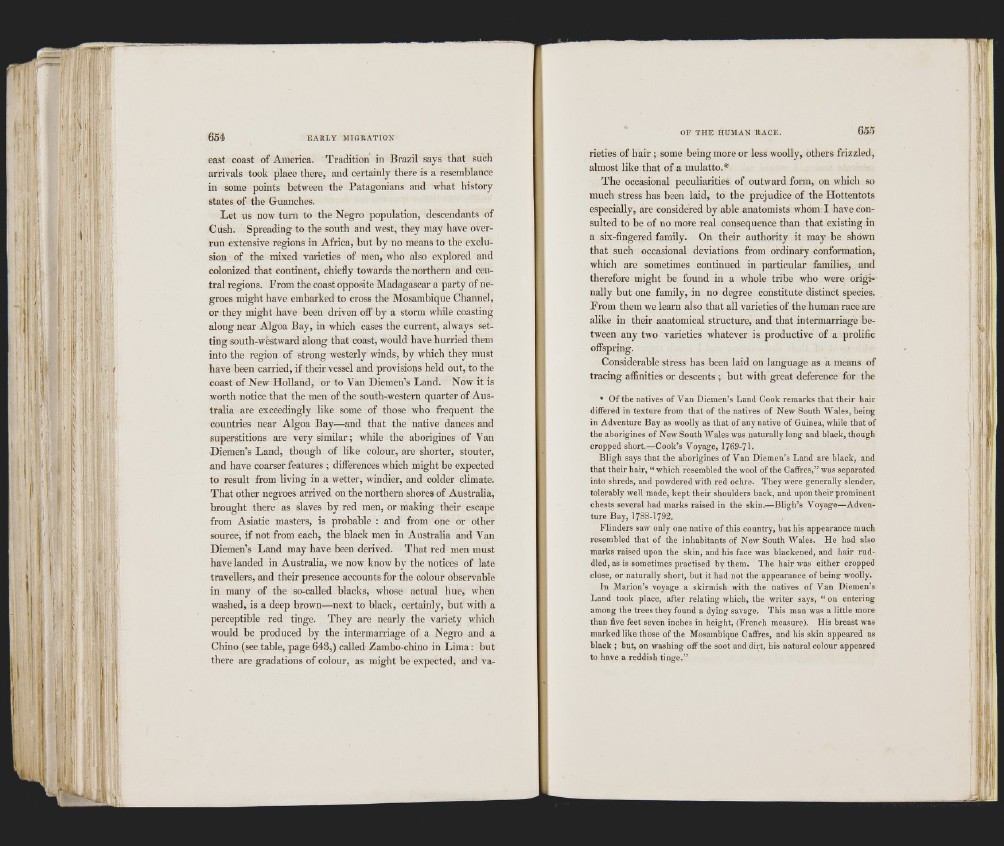
I
■ i ’ft
lj i f• ti IK
f ,1
:h
east coast of America. Tradition in Brazil says that such
arrivals took place there, and certainly there is a resemblance
in some points between the Patagonians and what history
states of the Guanches.
Let us now turn to the Negro population, descendants of
Cush. Spreading to the south and west, they may have overrun
extensive regions in Africa, but hy no means to the exclusion
of the mixed varieties of men, who also explored and
colonized that continent, chiefly towards the northern and central
regions. From the coast opposite Madagascar a party of negroes
might have embarked to cross the Mosambique Channel,
or they might have been driven off by a storm while coasting
along near Algoa Bay, in which cases the current, always setting
south-wéstward along that coast, would have hurried them
into the region of strong westerly winds, by which they must
have been carried, if their vessel and provisions held out, to the
coast of New Holland, or to Van Diemen’s Land. Now it is
worth notice that the men of the south-western quarter of Australia
are exceedingly like some of those who frequent the
countries near Algoa Bay—and that the native dances and
superstitions are very similar; while the aborigines of Van
Diemen’s Land, though of like colour, are shorter, stouter,
and have coarser features ; differences which might be expected
to result from living in a wetter, windier, and colder climate.
That other negroes arrived on the northern shores of Australia,
brought there as slaves by red men, or making their escape
from Asiatic masters, is probable : and from one or other
source, if not from each, the black men in Australia and Van
Diemen’s Land may have been derived. That red men must
have landed in Australia, we now know by the notices of late
travellers, and their presence accounts for the colour observable
in many of the so-called blacks, whose actual hue, when
washed, is a deep brown—next to black, certainly, but with a
perceptible red tinge. They are nearly the variety which
would be produced by the intermarriage of a Negro and a
Chino (see table, page 643,) called Zamho-chino in Lima: hut
there are gradations of colour, as might he expected, and varieties
of h a ir; some being more or less woolly, others frizzled,
almost like that of a mulatto.*
The occasional peculiarities of outward form, on which so
much stress has been laid, to the prejudice of the Hottentots
especially, are considered by ahle anatomists whom I have consulted
to be of no more real consequence than that existing in
a six-fingered family. On their authority it may he shown
that such occasional deviations from ordinary conformation,
whicli are sometimes continued in particular families, and
therefore might be found in a whole tribe who were originally
but one family, in no degree constitute distinct species.
From them we learn also that all varieties of the human race are
alike in their anatomical structure, and that intermarriage between
any two varieties whatever is productive of a prolific
offspring.
Considerable stress has been laid on language as a means of
tracing affinities or descents ; but with great deference for the
* Of the natives of Van Diemen’s Land Cook remarks that their hair
differed in texture from that of the natives of New South Wales, being-
in Adventure Bay as woolly as that of any native of Guinea, while that of
the aborigines of New South Wales was naturally long and black, though
cropped short.—Cook’s Voyage, 1769-7L
Bligh says that the aborigines of Van Diemen’s Land are black, and
that their hair, “ which resembled the wool of the Caffres,” was separated
into shreds, and powdered with red ochre. They were generaUy slender,
tolerably weil made, kept their shoulders back, and upon their prominent
chests several had marks raised in the skin.—Bligh’s Voyage—Adventure
Bay, 1788-1792.
Flinders saw only one native of this country, hut his appearance much
resembled that of the inhabitants of New South Wales. He had also
marks raised upon the skin, and his face was blackened, and hair ruddled,
as is sometimes practised by them. The hair was either cropped
close, or naturally short, hut it had not the appearance of heina: woolly.
In Marion’s voyage a skirmish with the natives of Van Diemen’s
Land took place, after relating which, the writer says, “ on entering
among the trees they found a dying savage. This man was a little more
than five feet seven inches in height, (French measure). His breast was
marked like those of the Mosambique Caffres, and his skin appeared as
black ; but, on washing off the soot and dirt, his natural colour appeared
to have a reddish tinge.”